No other farm machine is so identified with the hazards of production agriculture as the tractor. The rubber-wheeled, row-crop tricycle tractor of the 1930's revolutionized production agriculture. The tractor had the speed, power, flexibility, adaptability, and handling ease that helped move farming from the horse power era into the machine power era. The later additions of hydraulics, the three-point hitch, direct engine-driven power take-off (PTO), and variable shift transmissions firmly established the tractor as the primary machine in modern farming.
CENTER OF GRAVITY
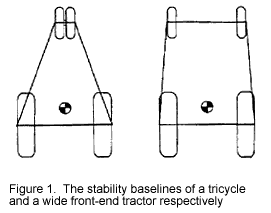 The central concept in tractor stability/instability is Center
of Gravity (CG). A tractors CG is the point where all parts
balance one another. For example, when a two-wheel drive tractor
is sitting with all wheels on level ground, the CG is typically
about 10 inches (25.4 cm) above and two feet (0.6 m) in front
of the rear axle, and in the center of the tractor body. This
results in approximately 30 percent of the tractor weight on
the front axle, and 70 percent on the rear axle. For four wheel
drive and center-articulated tractors, the CG is located slightly
more forward. Added weights also effect the CG.
The central concept in tractor stability/instability is Center
of Gravity (CG). A tractors CG is the point where all parts
balance one another. For example, when a two-wheel drive tractor
is sitting with all wheels on level ground, the CG is typically
about 10 inches (25.4 cm) above and two feet (0.6 m) in front
of the rear axle, and in the center of the tractor body. This
results in approximately 30 percent of the tractor weight on
the front axle, and 70 percent on the rear axle. For four wheel
drive and center-articulated tractors, the CG is located slightly
more forward. Added weights also effect the CG.
For a tractor to stay upright, its CG must stay within the tractors stability baseline. Stability baselines are imaginary lines drawn between points where tractor tires contact the ground. The line connecting the rear tire contact points is the rear stability baseline, while the lines connecting the rear and front tires on the same side are the side stability baselines. Front stability baselines exist but have limited use in stability/instability considerations, and are not normally include in such discussions. See Figure 1 for a complete illustration of a tractors CG and stability baselines.
While a tractor's CG does not move, its relationship with stability baselines may change. This most often occurs as the tractor moves from a level position onto a slope. A changing CG-stability baseline relationship means the tractor is moving toward an unstable position. If the CG-stability baseline relationship changes significantly (e.g. tractor CG vector moves beyond the stability baseline), the tractor rolls over. Tractor CG action is no different from the CG action on any other mobil vehicle. What differs is that tractors have a higher CG when compared to most other vehicles, such as automobiles and trucks. The higher CG on modern tractors is an inherent design characteristic and relates to their operation over crops, residue, and rough terrain. Changing tractor design so that their CG is significantly lowered would largely defeat the purpose for having farm tractors.
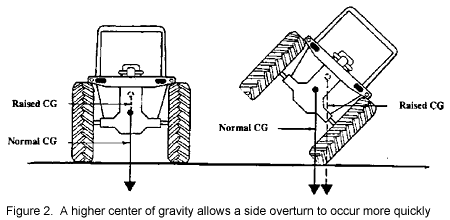 When a tractor is on an incline, the distance between the
tractors CG and stability baseline is reduced. If equipment,
such as a front-end loader, a round bale lifting fork, or
a chemical side saddle tank is mounted on the tractor, the
additional weight shifts the CG toward that piece of equipment.
As mounted equipment is raised, the CG is raised. As Figure
2 illustrates, a higher CG decreases tractor stability. In
many normal working situations, ground terrain and mounted
equipment combine to reduce the distance between the equipments
CG and stability baselines.
When a tractor is on an incline, the distance between the
tractors CG and stability baseline is reduced. If equipment,
such as a front-end loader, a round bale lifting fork, or
a chemical side saddle tank is mounted on the tractor, the
additional weight shifts the CG toward that piece of equipment.
As mounted equipment is raised, the CG is raised. As Figure
2 illustrates, a higher CG decreases tractor stability. In
many normal working situations, ground terrain and mounted
equipment combine to reduce the distance between the equipments
CG and stability baselines.
Other factors important to tractor stability/instability include centrifugal force (CF), rear-axle torque (RAT), and drawbar leverage (DBL). Each of these factors works through the CG. Saying this another way, each of these factors may cause the tractor's CG to go beyond the tractor's stability baseline and overturn.
CENTRIFUGAL FORCE
The relationship between CF and tractor speed, however, is not directly proportional. Centrifugal force varies in proportion to the square of the tractors speed. For example, doubling tractor speed from 3 mph to 6 mph increases the strength of centrifugal force four times (22 = 2 x 2 = 4). Tripling tractor speed from 3 mph to 9 mph increases CF nine times (32 = 3 x 3 = 9).
Centrifugal force is often a factor in tractor side overturns. When the distance between the tractor's CG and side stability baseline is already reduced from being on a hillside, only a little CF force may be needed to push the tractor over. Centrifugal force is what usually pushes a tractor over when the tractor is driven too fast during a turn, or during road travel. During road travel rough roads may result in the tractors front tires bouncing and landing in a turned position. Over correcting steering if the tractor starts to veer off the road is another example where CF is a factor in side overturns. The location of CG and amount of CF are points of stability/instability information tractor operators do not have at their disposal.
REAR-AXLE TORQUE
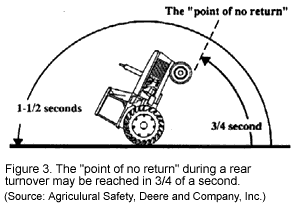 Rear-axle torque involves energy transfer between the tractor
engine and the rear axle of two-wheel drive tractors. Engaging
the clutch of such tractors results in a twisting force, called
torque, to the rear axle. This torque is then transferred to
the tractor tires. Under normal circumstances the rear axle
(and tires) should rotate and the tractor will move ahead. In
lay terms, the rear axle is said to be rotating about the tractor
chassis. If the rear axle should be unable to rotate, t e tractor
chassis rotates about the axle. This reverse rotation results
in the front-end of the tractor lifting off the ground until
the tractor's CG passes the rear stability baseline. At this
point the tractor will continue rearward from its own weight
until it crashes into the ground or other obstacle. The most
common examples of this happening are when the rear tractor
tires are frozen to the ground, are stuck in a mud hole, or
are blocked from rotating by the operator.
Rear-axle torque involves energy transfer between the tractor
engine and the rear axle of two-wheel drive tractors. Engaging
the clutch of such tractors results in a twisting force, called
torque, to the rear axle. This torque is then transferred to
the tractor tires. Under normal circumstances the rear axle
(and tires) should rotate and the tractor will move ahead. In
lay terms, the rear axle is said to be rotating about the tractor
chassis. If the rear axle should be unable to rotate, t e tractor
chassis rotates about the axle. This reverse rotation results
in the front-end of the tractor lifting off the ground until
the tractor's CG passes the rear stability baseline. At this
point the tractor will continue rearward from its own weight
until it crashes into the ground or other obstacle. The most
common examples of this happening are when the rear tractor
tires are frozen to the ground, are stuck in a mud hole, or
are blocked from rotating by the operator.
A tractor may overturn from rear axle torque before an operator realizes that the overturn is imminent. Remember that the CG of a tractor is found closer to the rear axle than the front axle. Because of this, a tractor may only have to rear to about 75 degrees from a level surface before its CG passes the rear stability baseline and continues on over. This position is commonly called the point of no return (see Figure 3). Research has shown that a tractor may reach this position in 3/4 of a second, and that it may take an operator longer than this to successfully stop the rearward motion. There are many tractor operating situations where there is even less than 3/4 of a second to recognize and successfully react to an impending rear overturn. For example, when a tractor is in a deep hole, or is traveling up a steep incline, the distance between the tractors CG and rear stability baseline is narrowed. If excessive rear axle torque is applied, the tractor will reach the point of no return more quickly. Figure 4 illustrates this situation.
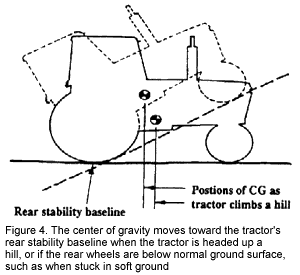 Four-wheel drive tractors are less susceptible to the rear
axle torque hazard than two-wheel drive tractors because torque
is applied to both the front and rear axles and tires. Also,
more weight is carried on the front axle, moving the CG forward.
These features lessen the tendency of the front of four-wheeled
drive tractors to lift off the ground. But, once the front
end does lift, there is little practical difference between
two- and four-wheeled drive tractors.
Four-wheel drive tractors are less susceptible to the rear
axle torque hazard than two-wheel drive tractors because torque
is applied to both the front and rear axles and tires. Also,
more weight is carried on the front axle, moving the CG forward.
These features lessen the tendency of the front of four-wheeled
drive tractors to lift off the ground. But, once the front
end does lift, there is little practical difference between
two- and four-wheeled drive tractors.
DRAWBAR LEVERAGE
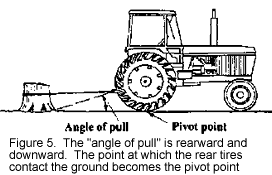 A tractor, including its drawbar, is designed to safely counteract
the rearward tipping action of pulled loads. When loads are
attached to a tractor at any point other than its designed
location, the design of the tractor for pulling loads is defeated.
A tractor pulling a tree stump can be used as an example to
show the effects of safe and unsafe hitching. Assumptions
for this example include a tree stump that does not budge,
a log chain that does not break, and a tractor with properly
ball sted (weighted) tires and an engine that does not stall.
A tractor, including its drawbar, is designed to safely counteract
the rearward tipping action of pulled loads. When loads are
attached to a tractor at any point other than its designed
location, the design of the tractor for pulling loads is defeated.
A tractor pulling a tree stump can be used as an example to
show the effects of safe and unsafe hitching. Assumptions
for this example include a tree stump that does not budge,
a log chain that does not break, and a tractor with properly
ball sted (weighted) tires and an engine that does not stall.
Suppose the tractor is hitched safely, that is, the log chain wrapped around the tree stump is attached to the tractor drawbar. The tractor is engaged and begins to pull on the stump. When the tree stump does not pull loose, the tractor will react in one of two ways. The most expected reaction will be a slipping (spinning) of the rear tires. This will continue until the operator stops the tractor. The second reaction may also involve a slipping of the rear tires, but the slipping may be neither smooth nor consistent. That is, they may slip with a jerking motion, and one tire may slip more than the other. Either one of these conditions may lead to a lifting of the front end of the tractor.
When the front end of the tractor lifts, the rear drawbar of the tractor will lower. This is a function of tractor geometry. The higher the front end raises, the lower the rear drawbar is driven. As the drawbar lowers, the angle of pull and the leverage the load has to tip a tractor rearward is also lowered. By design, a load will always lose its ability to tip a tractor rearward before the tractors CG reaches the rear stability baseline. As the load loses its ability to continue to tip he tractor rearward, the front end falls back to the ground. If the tractor operator doesn't stop the pulling action, the entire process will repeat itself, resulting in a bouncing of the tractor's front end.
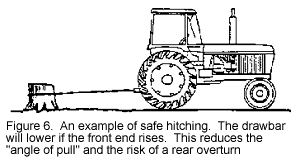 On the other hand, hitching unsafely, for example to a point
higher than the drawbar, increases the angle of pull and leverage
of a load. As the tractor tips rearward, these might not reduce
to a harmless level before the tractors CG reaches the rear
stability baseline. When a load is hitched to a rear axle,
the angle of pull and leverage do not reduce as the front
end raises because the location of the hitch point (rear axle)
stays constant throughout the rearward tip. A higher hitch
poi t also increases the pressure of the rear tires against
the ground. This may prevent the rear tires from slipping.
When the rear tires stop slipping, rear axle torque will begin
lifting the front end. Accident reports suggest that most
cases of improper hitching are associated with pulling and
dragging nonmobile objects such as tree stumps, logs, fence
posts, boulders, nonwheeled equipment such as large livestock
feeders and tanks, and farm equipment mired in mud. The tractor
operator is often tempted to hitch above the drawbar to lift
the load while pulling it. Figures 6 and 7 illustrate safe
and unsafe hitching.
On the other hand, hitching unsafely, for example to a point
higher than the drawbar, increases the angle of pull and leverage
of a load. As the tractor tips rearward, these might not reduce
to a harmless level before the tractors CG reaches the rear
stability baseline. When a load is hitched to a rear axle,
the angle of pull and leverage do not reduce as the front
end raises because the location of the hitch point (rear axle)
stays constant throughout the rearward tip. A higher hitch
poi t also increases the pressure of the rear tires against
the ground. This may prevent the rear tires from slipping.
When the rear tires stop slipping, rear axle torque will begin
lifting the front end. Accident reports suggest that most
cases of improper hitching are associated with pulling and
dragging nonmobile objects such as tree stumps, logs, fence
posts, boulders, nonwheeled equipment such as large livestock
feeders and tanks, and farm equipment mired in mud. The tractor
operator is often tempted to hitch above the drawbar to lift
the load while pulling it. Figures 6 and 7 illustrate safe
and unsafe hitching.
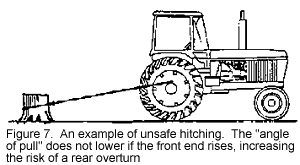 Tractors trying to pull a load up an incline take less leverage
to flip rearward because the tractors CG is closer to the
rear stability baseline. It is also possible to flip a tractor
rearward when the load is properly hitched to the drawbar.
This may happen when several factors occur. If the tractor
is headed up an incline at too fast a speed and the load,
such as a large log, suddenly digs into the ground, the rearward
pull may be so quick and strong that the momentum generated
by the rearward lift may result in a rear overturn.
Tractors trying to pull a load up an incline take less leverage
to flip rearward because the tractors CG is closer to the
rear stability baseline. It is also possible to flip a tractor
rearward when the load is properly hitched to the drawbar.
This may happen when several factors occur. If the tractor
is headed up an incline at too fast a speed and the load,
such as a large log, suddenly digs into the ground, the rearward
pull may be so quick and strong that the momentum generated
by the rearward lift may result in a rear overturn.
ROLL-OVER PROTECTIVE STRUCTURE AND SEAT BELT
A ROPS often limits the degree of rollover, which may reduce the probability of injury to the operator. A ROPS with enclosed cab further reduces the likelihood of serious injury because the operator is protected by the sides and windows of the cab. This assumes that cab doors and windows are not removed.
Publication #: Fact Sheet Safety-34
This document is from the Pennsylvania State University Pennsylvania Cooperative Extension Service. For more information, contact Pennsylvania State University College of Agricultural Sciences, Agricultural Engineering Department, 246 Agricultural Engineering Building, University Park, PA 16802. Publication date: 1991.
Dennis J. Murphy, professor, Agricultural Engineering Department, Cooperative Extension Service, Pennsylvania State University, University Park, PA 16802.
Disclaimer and Reproduction Information: Information in NASD does not represent NIOSH policy. Information included in NASD appears by permission of the author and/or copyright holder. More